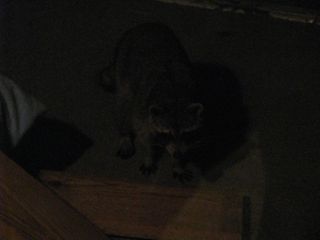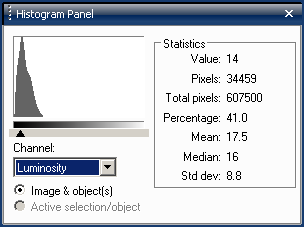How to Salvage Photos Gone Horribly Wrong
Not everybody has time to learn photography 101. Here’s how to make the best of bad images after the damage has been done, with software.
Working with the Unbearably Bad Photo–Getting Started
Every once in a while, you grab your camera to catch an image that’ll only be there for a second, and the picture turns out… unbearably bad. Such was the case with a friend trying to catch a photo of a raccoon on her porch.
Since she was shooting through a glass window, she couldn’t use the flash (all you end up with is a photo of a flash bulb reflecting in the window). She had no time to change aperture or shutter settings, and this magnificent piece of digital imagery was the result.

I mentioned the histogram in the beginning of this article. A histogram is essentially a graph showing the distribution of pixels from the dark to middle to light areas of an image. In theory, a typical well-shot (or well-corrected) image will have a histogram with data stretching from the far left to the far right of the graph, reflecting a complete range of dark to mid-tone to bright pixels.
As you might suspect, the histogram for the raccoon image does not show an even display of pixels spread out across the tonal range. Instead, it shows pixels concentrated on the left side of the histogram, indicating an overly dark image.

Sign up to get the BEST of Tom's Guide direct to your inbox.
Get instant access to breaking news, the hottest reviews, great deals and helpful tips.
Current page: Working with the Unbearably Bad Photo–Getting Started
Prev Page Keeping the Ocean Blue with Color Thumbnails Next Page Working with the Unbearably Bad Photo –Making Progress-
superhighperf how about fixing the photo that was in the cover?Reply
http://media.bestofmicro.com/adjustment-saturation-tuning,0-4-178852-2.jpg
bait and switch article ?!?!?!?! -
As a professional VFX artist, I have to say that this article is a little on the juvenile side. Some of the "after" photos contain less information than the "before" photos. You never want to clip information in your photograph, and always want even exposure. Never underestimate a good matte for affecting only certain portions of your image. Furthermore, a good levels adjustment never hurt, and can always add some "punch" to your image.Reply
-
The article text provides a reasonable introduction to basic photo editing, but the "fixed" photos are perfect examples of what happens when a beginner goes way, way overboard. It's too bad because the miserable "after" photos significantly undermine the credibility of the article.Reply
-
mediv42 Why do people insist a bluer sky or greener trees make a better picture? Isn't the point of photography to capture what actually is, not whimsically change it to what you want it to be? Sure I understand if you underexposed the photo, or your white balance is off or whatever, but shouldn't the goal generally be what the subject actually looked like?Reply -
idisarmu This reminds me of the millions upon millions of teenage girls who see a picture of themselves and say, "Oh noes!!! ACNE!" *cries for hours and then suddenly has epiphany* "WAIT! I've GOT IT! I'll just crank up the brightness and make the picture black&white! THANK YOU COMPUTER!"Reply -
AARRGGHHH idisarmuThis reminds me of the millions upon millions of teenage girls who see a picture of themselves and say, "Oh noes!!! ACNE!" *cries for hours and then suddenly has epiphany* "WAIT! I've GOT IT! I'll just crank up the brightness and make the picture black&white! THANK YOU COMPUTER!"Reply
Black and White hides zits? That IS an epiphany.
I enjoyed the article.
